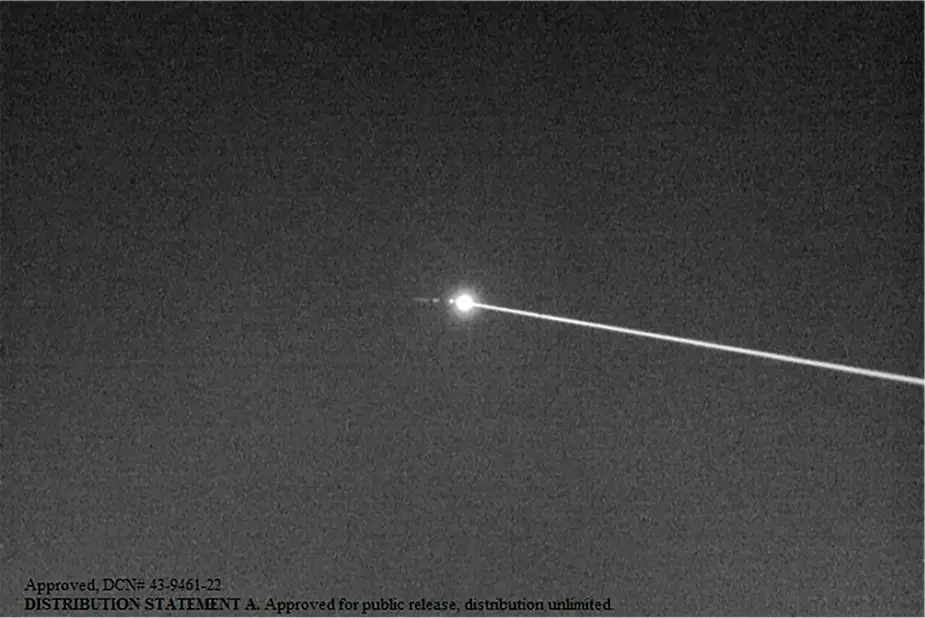Breaking news
US Navy conducts historic test of a new Laser Weapon on drone.
According to information published by the U.S. Department of Defense on April 13, 2022, the U.S. Navy conducted a historic test of a new Laser Weapon System against a drone.
Follow Navy Recognition on Google News at this link
 Drone targeted by the new Laser Weapon System (Picture source: Lockheed Martin)
Drone targeted by the new Laser Weapon System (Picture source: Lockheed Martin)
The ground-based laser system homed in on the red drone flying by, shooting a high-energy beam invisible to the naked eye. Suddenly, a fiery orange glow flared on the drone, smoke poured from its engine and a parachute opened as the craft tumbled downward, disabled by the laser beam.
The February demonstration marked the first time the U.S. Navy used an all-electric, high-energy laser weapon to defeat a target representing a subsonic cruise missile in flight.
Layered Laser Defense (LLD)
Known as the Layered Laser Defense (LLD), the weapon was designed and built by Lockheed Martin to serve as a multi-domain, multi-platform demonstration system.
It can counter unmanned aerial systems and fast-attack boats with a high-power laser—and also use its high-resolution telescope to track in-bound air threats, support combat identification, and conduct battle damage assessment of engaged targets.
The drone shoot-down by the LLD was part of a recent test sponsored by the Office of Naval Research (ONR) at the U.S. Army’s High Energy Laser Systems Test Facility at White Sands Missile Range in New Mexico. The demonstration was a partnership between ONR, the Office of the Under Secretary of Defense (Research and Engineering) and Lockheed Martin.
The LLD testing supports a broader effort by the naval research and development community, partnered closely with the fleet, to mature technologies and field a family of laser weapons that can address multiple threats using a range of escalating options. These capabilities range from non-lethal measures, such as optical “dazzling” and disabling of sensors, to destruction of a target.
Laser weapons provide new precision and speed of engagement for naval warfighters. They also offer simplified logistics that are safer for ships and their crews, as lasers are not dependent on the traditional propellants or gunpowder-based ordnance found on ships.
Instead, modern high-power lasers run on electricity, making them inherently safer and able to provide weapon capability as long as a ship has power. This also means the cost per engagement for a laser weapon can be very low, since the only consumable item expended is fuel to run the system.
For years, the Department of Defense (DoD) and all the Services have recognized the promise of directed-energy weapons such as lasers, and continue to prioritize research. Recently, the Under Secretary of Defense for Research and Engineering, the Hon. Heidi Shyu, re-affirmed that directed energy is one of the DoD’s critical technology areas.
ONR plays an important role in developing technologies for laser weapons and has fielded demonstration systems for operational experimentation. Notably, in 2014 ONR saw the Laser Weapon System tested successfully aboard the USS Ponce in the Persian Gulf. More recently, ONR fielded the Laser Weapon System Demonstrator aboard the USS Portland in 2021.
Although there’s no plan to field the LLD, it offers a glimpse into the future of laser weapons. It is compact and powerful, yet more efficient than previous systems. It has specialized optics to observe a target and focus laser beams to maximum effect, while also incorporating artificial intelligence to improve tracking and targeting.
During the recent test at White Sands, the LLD tracked or shot down an array of targets—including unmanned fixed-wing aerial vehicles, quadcopters, and high-speed drones representative of subsonic cruise missiles.
In March 2020, Lockheed Martin was awarded a $22,436,852 contract for the integration, demonstration, testing, and operation of the Layered Laser Defense (LLD) weapon system prototype onboard a U.S. Navy's Littoral Combat Ship (LCS).



























